|
VI -
REPRESENTATING FRACTION MEASUREMENTS
|
|
< INDEX
|
Measuring things accurately
when things are small or very small requires dealing with parts of
whole objects and thus also in real life, parts of "standard
units of measurement". That is the case, for example, when we
refer to "one-half", "three-fifths", or
"seven-thousandths" of an object, or a meter, foot, or any
other unit of measurement. These expressions refer to convenient and
accurate descriptions of incomplete quantities that can be small or
extremelly small parts of something. This is the topic of this
chapter.
(In
the school curriculum for the K-12 grades, the topic of fractions
appears in various themes of different subjects, but more
specifically, in the most current academic standards for the subjects
of mathematics and science (CCSS
"Common Core" - Mathematics Standards , and NGSS
"New Generation" - Science Standards):
CCSS.Math.Content.3.NF.A.2 Understand
a fraction as a number on the number line; represent fractions on a
number line diagram.
CCSS.Math.Content.4.NF.B.3 Understand
a fraction a/b with a >
1 as a sum of fractions 1/b.
CCSS.Math.Content.4.NF.B.4 Apply
and extend previous understandings of multiplication to multiply a
fraction by a whole number (including first: "a whole
number by a fraction").
CCSS.Math.Content.4.NF.C.6 Use
decimal notation for fractions with denominators 10 or 100. For
example, rewrite 0.62 as 62/100; describe a length as 0.62 meters;
locate 0.62 on a number line diagram.
CCSS.Math.Content.5.NF.A.1 Add
and subtract fractions with unlike denominators (including mixed
numbers) by replacing given fractions with equivalent fractions in
such a way as to produce an equivalent sum or difference of
fractions with like denominators. For example, 2/3 + 5/4 =
8/12 + 15/12 = 23/12. (In general, a/b + c/d = (ad + bc)/bd.)
CCSS.Math.Content.5.NF.B.4 Apply
and extend previous understandings of multiplication to multiply a
fraction or whole number by a fraction.
CCSS.Math.Content.5.NF.B.5 Interpret
multiplication as scaling (resizing).
Science
and engineering practices in the NGSS
1. Asking questions (for science) and defining problems
(for engineering) 2. Developing and using models 3. Planning and
carrying out investigations 4. Analyzing and interpreting data 5.
Using mathematics and computational thinking 6. Constructing
explanations (for science) and designing solutions (for engineering)
7. Engaging in argument from evidence 8. Obtaining, evaluating, and
communicating information.
Representing fractions
Call
the Representing
Pieces of One Whole display.
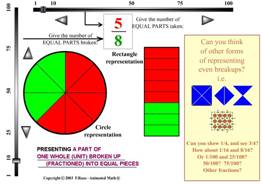 This
display features the visual representation of fractions, as a
collection of a number of equal parts of a whole unit (“EVEN
BREAKUPS”). Both the total number of equal parts of the whole,
as well as the selected partial number of them, are set by using
corresponding slider bars (left and top). The fractions are shown in
both circle and rectangle forms, offering visual displays of how
portions of "a whole thing" can be represented using even,
manageable breakups of a “unit”, as convenient for
practical uses.
This
display features the visual representation of fractions, as a
collection of a number of equal parts of a whole unit (“EVEN
BREAKUPS”). Both the total number of equal parts of the whole,
as well as the selected partial number of them, are set by using
corresponding slider bars (left and top). The fractions are shown in
both circle and rectangle forms, offering visual displays of how
portions of "a whole thing" can be represented using even,
manageable breakups of a “unit”, as convenient for
practical uses.
The concept and methods of
FRACTIONS are the way we implement higher accuracy and precision into
our practices of measurement.
HANDS ON:
Wide-screen/Wireless-mouse or Touch-Screen
1.- Identify the
parts of the display, including the CIRCLE and RECTANGLE image forms
of fractions, the DENOMINATOR and NUMERATOR numbers, and their
size-control slider bars (left and top).
2.- Use the slider
bars of the display to represent the following fractions, and then
draw, by hand, on a piece of paper, the resulting images (drawing
pages can be obtained and printed from:
www://animath.net/drawfracts1.pdf):
|
|
Circle
|
Rectangle
|
|
1/2
"one out-of-two"
or "one half"
|
DRAW
|
DRAW
|
|
1/3
"one out-of-three"
or "one third "
|
DRAW
|
DRAW
|
|
1/4
"one out-of-four"
or "one fourth "
|
DRAW
|
DRAW
|
|
1/5
"one out-of-five"
or "one fifth "
|
DRAW
|
DRAW
|
|
1/100
"one hundredth"
|
DRAW
|
DRAW
|
|
2/3
"two
out-of-a three" or "two thirds "
|
DRAW
|
DRAW
|
|
3/4
"three
fourths"
|
DRAW
|
DRAW
|
|
5/16
"five
sixteenths"
|
DRAW
|
DRAW
|
|
25/100
"twentyfive
hundredths"
|
DRAW
|
DRAW
|
|
75/100
"seventyfive
hundredths"
|
DRAW
|
DRAW
|
* The same fraction
examples of this activity can be used to help develop mastery in
visualizing fractions, by measuring the time taken to obtain each
representation on the screen (e.g. multiple students in a computer
lab) in the shortest time possible, using the timer located in the
blue section ("TIMER ENABLE ") at the bottom of the display
: When
the yellow button is first pressed, the timer for each student will
be set from OFF, to a READY mode, waiting for the screen actions
begin and the counting will start as soon as any of the controls of
the display are touched in each attempt. The
timer will keep counting elapsed seconds during each attempt, and
will stop only when the yellow button is pressed again, signaling
OFF, or "this attempt is finished".
The
count will then freeze and can be recorded in a separate log.
The counts of
different students can then be compared to determine "the
fastest" attempt from a group participant.
The yellow button
will then need to be pressed again to make the timer reset ready for
a new attempt or case.
QUESTION: What is the
smallest part possible in this display (Representing Pieces of One
Whole) that can help us be most accurate? one- onehundredth 1/100
PAPER-FOLD
FRACTIONS
Have
some 4 sheets of blank paper available to fold at your desk in
different ways, as requested next.
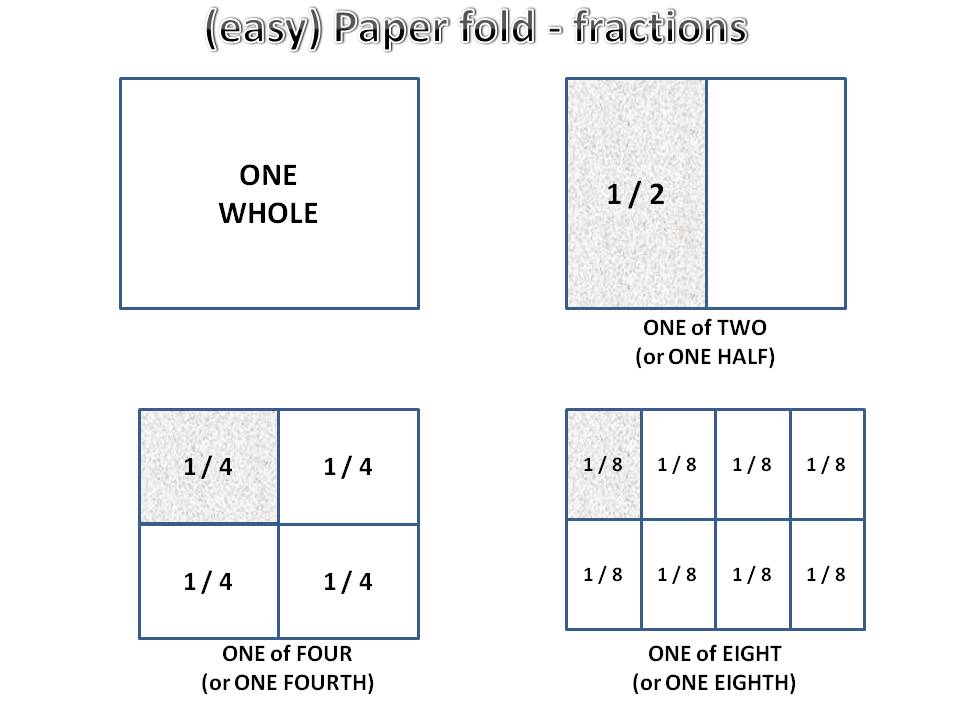
1.- Use a
standard paper sheet and a paper-plate to fold it in equal two/half
parts to represent: a) one-half, b) one-quarter, and c) one-eight. d)
if folding the one-eights stack in half once again, what would the
resulting fractions be?
2.- Can you try folding
another page or paper-plate to represent (cleanly and accurately)
one-third, or one-fifth? Why is this more difficult?
QUESTION: If we take three
equal sized sheets or pieces of paper, then join them all
together to become "one whole" thing or amount,
could this give us a good representation for one-third
fractions of any unit amount? Can we do the same for 5, 7, or any
other fractioning that is not multiple of 2? Can we do the same with
any other object or thing that has multiples in a group?
COMPARING
FRACTIONS
Call
the EQUIVALENT REPRESENTATIONS
display.
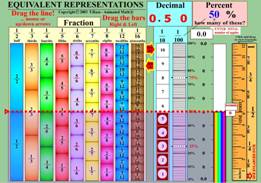 This
display allows side-by-side visual comparison of common fractions in
rectangular, strip-tile form.
This
display allows side-by-side visual comparison of common fractions in
rectangular, strip-tile form.
The left part of the display
presents a set of common fractions in strip form. The strips
can be slid horizontally, and placed near others of interest for
comparison. A dotted red-line-and-shade cover is also provided,
sliding up and down to highlight comparisons. At the center of
the diplay, the images of breakups by 10 and 100 pieces are available
together, to highlight their belonging in the uniform "Base-10"
or Decimal numeric, or Hindi-Arabic system that has prevailed in
counting, measurement, communication and computational activities
activities during most of the previous centuries. The fractioning
system based on the number 2, Base-2 or Binary system currently
prevailing is also illustrated further ahead in this chapter.
The images of a foot, and an
inch, and a “batch of apples” strip are also available
(right side of the display) for visualization of group partitioning
and common length measurement units (feet, inch).
The digital-numeric
representation for each of the pieces in each fraction-strip is shown
at the top. For example, every one of the 4 equal parts of the
green strip is named “1/4”, “one of four”, or
“one-fourth.
There are strips for halves
(1/2, blue), thirds (1/3, orange), fourths (1/4, green), fifths (1/5,
red), sixths (1/6, purple), sevenths (1/7, yellow), eights (1/8,
pink), tenths (1/10, white), twelfths (1/12, dark blue), sixteenths
(1/16, brown), hundredths (1/100, white).
HANDS ON:
Wide-screen/Wireless-mouse or Touch-Screen
1.- Describe the
parts of the display, including the sliding fraction strips, the
one-foot ruler, the one-inch, and the batch-of-apples strips. Show
how the dotted-line-shade slides up and down to assist comparisons
and equivalences across.
2.- Do the following,
using the dotted-line-shade:
a) Mark one half
(1/2). Which of the other fraction pieces shown can add up to
show exactly the same?
1) _____ 2) _____ 3)
_____ 4) _____ 5) _____ 6) ______ 7) ______
(
2/4, 3/6, 4/8, 6/12, 8/16, 5/10,
50/100 )
b) Mark one quarter
(1/4). Which of the other fraction pieces shown can add up to show
exactly the same?
1) ______ 2) ______
3) ______ 4) ______ (
2/8, 3/12, 4/16, 25/100 )
c) Mark two thirds
(2/3). Which of the other fraction pieces shown can add up to show
exactly the same?
1) ______ 2) ______
(
4/6, 8/12 )
d) Mark three
quarters (3/4). Which of the other fraction pieces shown can add up
to show exactly the same?
1) ______ 2) ______
3) ______ 4) ______ (
6/8, 9/12, 12/16, 75/100 )
e) Mark seven eighths
(7/8). Which of the other fraction pieces shown can add up to show
exactly the same?
1) ______
(
14/16 )
3.- Describe the two
strips in the “Decimal” box, to the right of the
1/16 fraction strip. These columns are the first two breakdowns
used by the decimal number system, which only considers breakdowns
and accumulations whose number of unit-parts are multiples of 10. The
decimal breakdowns for fractions are therefore in tenths (1/10),
one-hundredths (1/100), one-thousandths (1/1000), etc. The
representation using exclusively 1/100 unit-fractions is widely used
and referred to as “percents”.
4.- Use the
red-dotted line across the strips by clicking-and-dragging it, and
numerical calculations to show and determine exactly
the following:
a) One half (1/2).
What are the decimal and percent equivalents of one-half?
(
0.5, 50% )
b) One quarter
(1/4). What are the decimal and percent equivalents of
one-quarter? (
0.25, 25% )
c) Two thirds (2/3).
What are the decimal and percent equivalents of two-thirds?
(
0.66.., 66.66..% )
d) Three quarters
(3/4). What are the decimal and percent equivalents of
one-half? (
0.75, 75% )
e) Seven eights (7/8)
. What are the decimal and percent equivalents of
seven-eights? (
0.875, 87.5% )
5.- Describe how the
rainbow-colored column on the right side of the display is used to
show the number of items that will fall in a fraction of that unit
package. For example, if you enter 12 units at the top of the
rainbow colored column, 12 units (apples) will show to fill the
column, but only 6 of them will fall within a half of the unit
package.
6.- Use the display
and numerical calculations (multiplication for "fraction of...")
to answer the following questions:
a) Approximately how
many of 24 units are in one half (1/2, 0.50, or 50%) of the total?
______ (
12 )
b) Approximately how
many of the 24 units are contained in one quarter (1/4, 0.25, or 25%)
of the total? ______ (
6 )
c) Approximately how
many of the 24 units are contained in two-thirds (2/3, 0.66….,
or 66.6….%) of the total? ______
(
16 )
d) Approximately how
many of the 24 units are contained in three-quarters (3/4, 0.75, or
75%) of the total? ______ (
18 )
e) Approximately how
many of the 24 units are contained in ten-twelfths (10/12, 0.838….,
or 83.3….%) of the total? ______
(
20 )
7.- Focus on the
yellow one-foot ruler at the extreme right of the display is
available to show the number inches and/or parts of an inch contained
in fractions of it. The whole foot has 12 inches.
8.- Answer the
following questions:
a) Approximately how
many inches are in one half (1/2, 0.50, or 50%) of a foot?
______ (
6 )
b) Approximately how
many inches are in one quarter (1/4, 0.25, or 25%) of a foot?
______ (
3 )
b) Approximately how
many inches are in two-thirds (2/3, 0.66…., or 66.6….%)
of a foot? ______ (
8 )
b) Approximately how
many inches are in three-quarters (3/4, 0.75, or 75%) of a foot?
______ (
9 )
b) Approximately how
many inches, or parts of an inch are in one-sixteenth (1/16, 0.0625,
or 6.25%) of a foot? ______ (
¾ or 0.75 ).
THE SIZE OF
TOOLS
Call
the MONEY
FRACTIONS display.
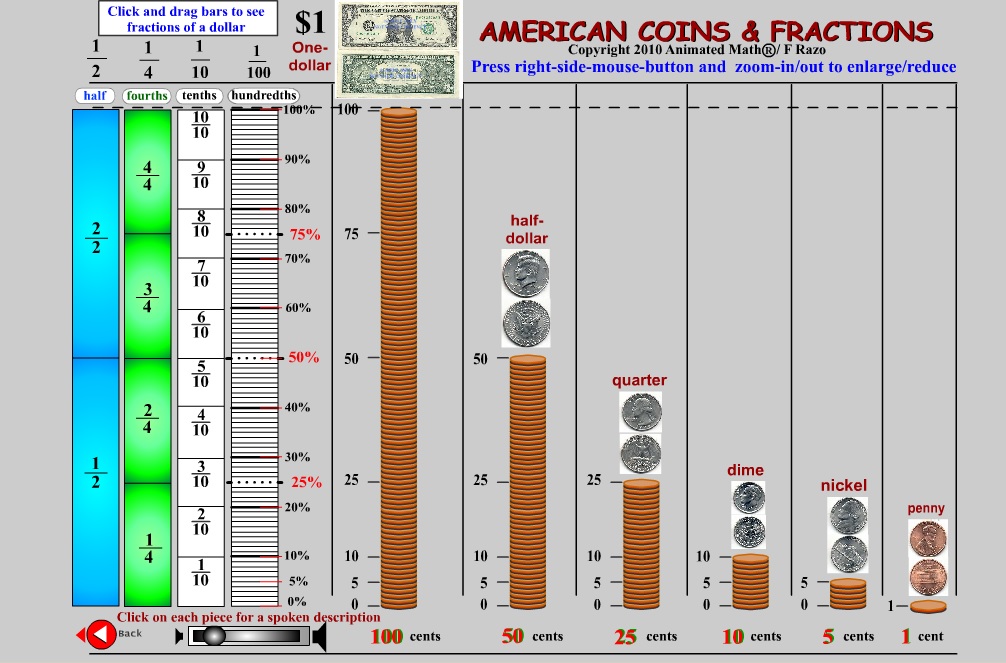 Here
we can see how the unit of money (Dollar) can be broken down into
parts (change) for buying and selling transactions. The common
fractions are: "half-dollars", "quarters",
"dimes", "nickels", and "pennies). Observe
how coins and dollar values can be made (or replaced) by using
(equivalent to) other smaller coins. This can be seen by moving
around and placing side-by-side the columns of the dollar and
fractional coins. When paying prices that are smaller than a dollar,
change can be produced for the excess value of the bill or coins.
Here
we can see how the unit of money (Dollar) can be broken down into
parts (change) for buying and selling transactions. The common
fractions are: "half-dollars", "quarters",
"dimes", "nickels", and "pennies). Observe
how coins and dollar values can be made (or replaced) by using
(equivalent to) other smaller coins. This can be seen by moving
around and placing side-by-side the columns of the dollar and
fractional coins. When paying prices that are smaller than a dollar,
change can be produced for the excess value of the bill or coins.
a) How many quarters
make one dollar? 4
b) How many dimes
make a dollar? 10
c) How many nickels
make a dollar? 20
d) How many pennies
is a dollar worth? 100
e) If you buy something
costing 75 cents, and you have one dollar, how many quarters would
you spend from it? 3 How many pennies would you receive back for
change? 25 How many nickels would you spend from your dollar, and how
many nickles would you receive for change? 15,
5
THE SIZE OF
TOOLS
Call
the MEASURING
TOOL SIZES display.
 This
display presents two sets of common nut-and-bolt wrenches, one using
the metric, the other using the English measurement system to specify
wrench size. The size of each wrench can be verified by using
the moveable ruler and small (yellow) strips provided, and visualized
better by using an appropriate zoom-in and zoom-out screen
magnification.
This
display presents two sets of common nut-and-bolt wrenches, one using
the metric, the other using the English measurement system to specify
wrench size. The size of each wrench can be verified by using
the moveable ruler and small (yellow) strips provided, and visualized
better by using an appropriate zoom-in and zoom-out screen
magnification.
The display takes the
opportunity to help students become familiar with the size markings
of typical wrench sets.
HANDS ON:
Wide-screen/Wireless-mouse or Touch-Screen
1.- Observe the
functionality of the display, by dragging each the “English Set
(inches)” ruler strip, onto the open end of the first ("5/16")
wrench, next to it, and the “Metric Set (inches)” ruler
strip, onto the open end of the first ("10") wrench, next
to it. Use the zoom-in feature, and further positioning of the
enhanced image, to observe the size scale for each wrench.
2.- Verify the size
of each of the remaining English set (top), and metric set (bottom)
wrenches.
MIXING AND
MATCHING FRACTIONS
Call
the MIXING
AND MATCHING FRACTIONS display.
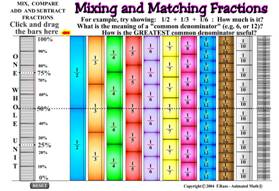 This
display contains a set of fraction strips with detachable fraction
sections. The ability to produce visual combinations of
fractions, mixing and matching as convenient can be used to present
visual representations of fraction operations:
This
display contains a set of fraction strips with detachable fraction
sections. The ability to produce visual combinations of
fractions, mixing and matching as convenient can be used to present
visual representations of fraction operations:
1.- Adding is done by
stacking pieces on top of other pieces
2.- Subtracting (or "taking
away") is done by overlapping and reducing (negative direction
or cancelling) quantity pieces down from the top height of the
amounts affected.
HANDS ON:
Wide-screen/Wireless-mouse or Touch-Screen
1.- Observe the
functionality of the display, by bringing one of the 1/2 (blue)
strips to the left staging area, and then A) adding 1/4 to it,
setting it over its top to 3/4, and B) subtracting 1/4 to the 1/2,
overlapping it down to 1/4 (remaining). Use the sliding
dotted-line marker to compare with other fraction strips on the right
side.
2.- Demonstrate,
visually, that 1/2 + 1/4 is approximately the same as 3/4 .
3.- Demonstrate,
visually, that 1/2 – 1/4 is approximately the same as 1/4 .
4.- Answer, visually,
the first question shown on the upper part of the display:
1/2 + 1/3 + 1/6 = ?
(visually seems like = 1)
5.- Answer the second
question shown on the upper part of the display: What is the meaning
of a common denominator? (a
piece size that can exactly replace all other pieces in a common
group)
6.- Answer the Third
question shown on the upper part of the display: How is the LEAST
common denominator (LCD) useful? (we
can then use the the least number of common-size pieces for
operations with the group)
7.-
Use the LCD (6) to show visually
that 1/2 + 1/3 + 1/6 is most exactly = 1.
8.- Represent
visually, and compute the result for each of the following questions,
using the dotted-line marker of the display:
|
Question:
|
Answer:
|
|
1/4
+ 1/2 =
|
|
|
1/2
- 1/4 =
|
|
|
3/4
- 1/2 =
|
|
|
1/2
+ 1/8 =
|
|
|
1/4
+ 1/3 + 1/6 =
|
|
|
1/2
+ 1/8 + 1/6 =
|
|
|
1/2
+ 1/3 - 1/6 =
|
|
|
1/2
- 1/3 + 1/6 =
|
|
|
3/4
+ 1/8 + 1/16 =
|
|
|
3/4
+ 1/8 - 1/16 =
|
|
|
1/10
+ 1/3 + 1/6 =
|
|
|
1/5
+ 1/8 - 1/6 =
|
|
MULTIPLYING
FRACTIONS
Call
the Fraction
of a Number display.
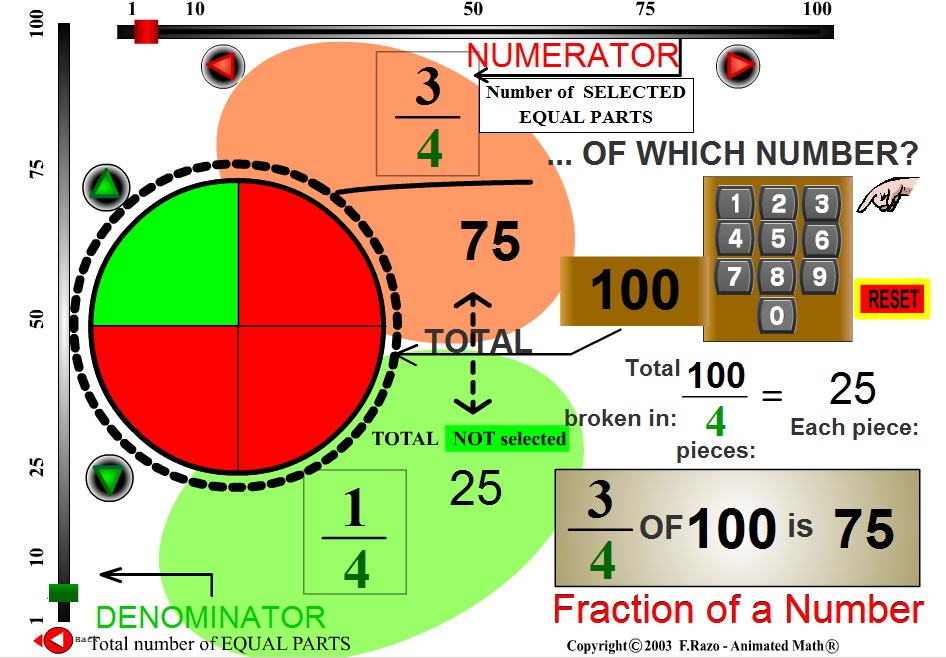 This
display produces a visual representation of the operation of
multiplication of a fraction by a whole (positive) number. The
operation is shown as extracting "a fraction of a TOTAL
number..." by breaking it into an equal number of pieces
(denominator), and selecting only "some" of them
(numerator), to contain the portion/fraction of interest of the total
number.
This
display produces a visual representation of the operation of
multiplication of a fraction by a whole (positive) number. The
operation is shown as extracting "a fraction of a TOTAL
number..." by breaking it into an equal number of pieces
(denominator), and selecting only "some" of them
(numerator), to contain the portion/fraction of interest of the total
number.
HANDS
ON: Wide-screen/Wireless-mouse or Touch-Screen
Try the following
operations:
|
1/2 of 50 ... 25
|
1/4
of 400 ... 100
|
|
1/3 of 30 ... 10
|
3/4
of 80 ... 60
|
|
2/5 of 50 ... 25
|
2/3
of 15 ... 10
|
|
25/100 of 200 ...
50
|
4/5
of 50 ... 25
|
|
1/4 of 4 ... 1
|
75/100
of 200 ... 150
|
|
1/4 of 40 ... 10
|
5/8
of 400 ... 250
|
Call the Pizza
ans Olives display.
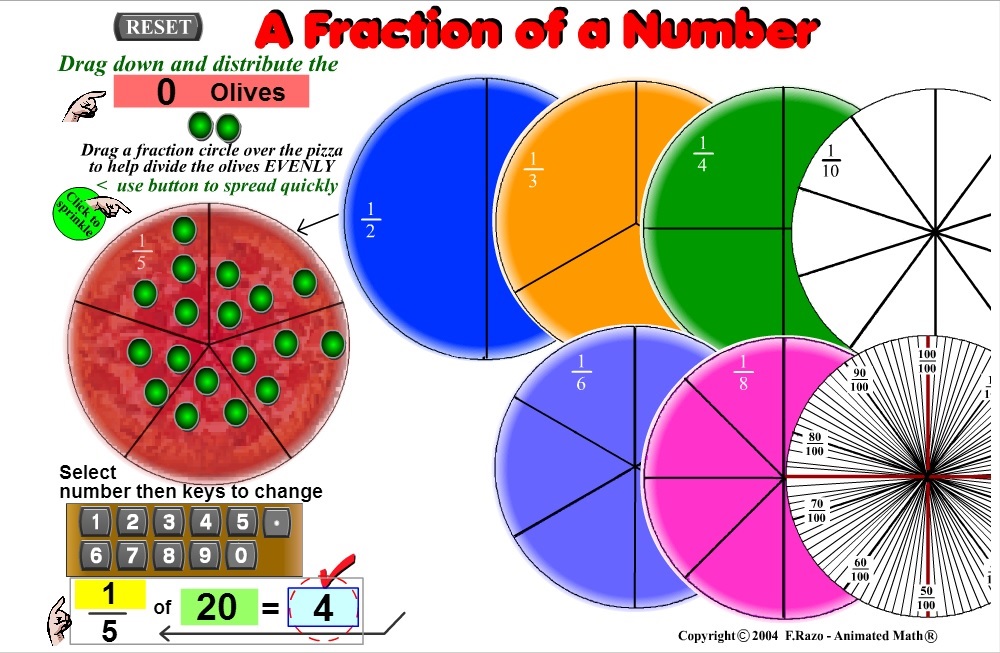 This
involves dispersing evenly (same amount) a number of olives
throughout a pizza broken down into an even number of fraction
pieces. Each olive is dragged in turn to the pizza to fill each and
all parts smootly, that is, by equal numbers of olives on each so
everyone sharing ot gets the same amount of olive flavor. This is
done by placing each new olive in turn over each piece, around and
round until they are all exhausted.
This
involves dispersing evenly (same amount) a number of olives
throughout a pizza broken down into an even number of fraction
pieces. Each olive is dragged in turn to the pizza to fill each and
all parts smootly, that is, by equal numbers of olives on each so
everyone sharing ot gets the same amount of olive flavor. This is
done by placing each new olive in turn over each piece, around and
round until they are all exhausted.
The activity allows also for
thinking of what will happen when there are no even amount of olives
left to disperse, to fill each part of pizza equally with the same
amount of olive content. In this situation, each part already has the
same number of whole olives, but there is still one or more left, but
not enough of whole olives to apportion into each part of the pizza.
What can it be done then to strictly give each part the same amount
(i.e. taste) by spreading the leftover olives?
HANDS ON:
Wide-screen/Wireless-mouse or Touch-Screen
1.- Select and drag
each of the fraction circle shades from the right and place one at a
time over the whole pizza. Observe how the the pizza is fractioned
for each selection. How
many people can be fed equally with each fractioning choice? Which
ones give more
quantity to
each person? Which ones give less? Which choice serves more
people? Which serves
less people?
2.- Choose the 1/4
fractioning shade, then select the lower green box by the numeric
keyboard below, to enter the number 12 for the number of olives
available in the group above. The image of the olives will be
updated. Click and drag each olive in the group to place them
sequentially onto the pizza parts evenly (that is, the same amount of
olives for each piece of pizza).
NOTE: Could use initially the
"Click to sprinkle" green button and then adjust
individually to speed up the distribution of olives on the pizza.
3.- Now choose the 1/3
fractioning shade, then select the lower green box by the numeric
keyboard below, to enter the number 11 for the number of olives
available in the group above. The image of the olives will be
updated. Click and drag each olive in the group to place them
sequentially onto the pizza parts evenly (that is, the same amount
for each piece of pizza). What can happen to the 2 leftover olives,
so we can get an even distribution of them on each and all the pieces
of the pizza?
What would be total final the
amount of olive ingredient on each of the 3 parts of the pizza?
COUNTING FRACTIONS
IN DIFFERENT NUMBER_BASE SYSTEMS
Call
the Count
and See Decimal Fractions (Base-10) display.
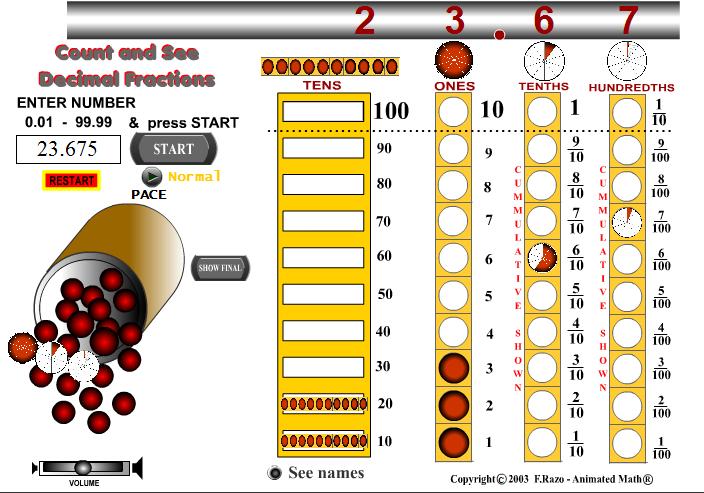 This
display features the animated collection of fraction pieces in the
decimal system, which considers representing all quantities
exclusively by grouping or units by tens, and similarly, breaking
down or partitioning units exclusively in numbers of pieces that are
multiples (fractions) or sub multiples of 10.
This
display features the animated collection of fraction pieces in the
decimal system, which considers representing all quantities
exclusively by grouping or units by tens, and similarly, breaking
down or partitioning units exclusively in numbers of pieces that are
multiples (fractions) or sub multiples of 10.
HANDS ON:
Wide-screen/Wireless-mouse or Touch-Screen
1.- Try the following
fractional decimal numbers, making sure to stop-suspend the counting
periodically (using the "Pace-step" button) to observe
current counts at different times during the accumulation:
a)
0.25
b) 0.75 b)
1.32 c)
12.475
Call the FRACTIONS
IN BASE-2 display.
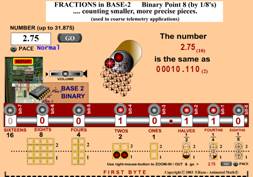 This
display features the animated collection of fraction pieces in the
binary, or base-2 system, which considers representing all quantities
exclusively by grouping or units by twos, and similarly, breaking
down or partitioning units exclusively in numbers of pieces that are
multiples (fractions) or sub multiples of 2. Because only three
"binary digits" are used to the right of the “binary
point” when representing fractional quantities, this permits a
breakdown of units up to one-eight, and therefore the format is
called “binary point eight”. This format has been
used extensively for remote measurement and communication of quantity
(telemetry), in automated industrial operations10.
This
display features the animated collection of fraction pieces in the
binary, or base-2 system, which considers representing all quantities
exclusively by grouping or units by twos, and similarly, breaking
down or partitioning units exclusively in numbers of pieces that are
multiples (fractions) or sub multiples of 2. Because only three
"binary digits" are used to the right of the “binary
point” when representing fractional quantities, this permits a
breakdown of units up to one-eight, and therefore the format is
called “binary point eight”. This format has been
used extensively for remote measurement and communication of quantity
(telemetry), in automated industrial operations10.
HANDS ON:
Wide-screen/Wireless-mouse or Touch-Screen
1.- Use the Fractions
in Base 2 display to count to the following fractional decimal
numbers. Make sure to stop-suspend the counting periodically (using
the "Pace-step" button) to observe current counts at
different times during the accumulation:
a)
0.25
b) 0.75
b) 1.32
c) 12.475
1.- Write a response
to the following question:
How
is the binary point eight format accuracy limited?
Use the BINARY
BASE-2 NUMBER KEYPAD or the Try
it! displays to practice expressing various numbers with
fractions in the Binary system.
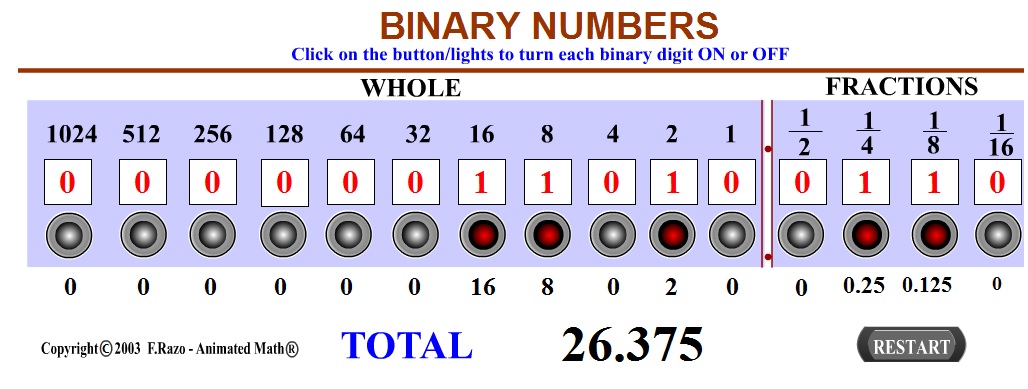 These
displays allow for the collection of place value unit integers and
fraction pieces as called or removed for by each "bit"
light/button pressed repeatedly.
These
displays allow for the collection of place value unit integers and
fraction pieces as called or removed for by each "bit"
light/button pressed repeatedly.
Call the FRACTIONS
4,000 years ago display.
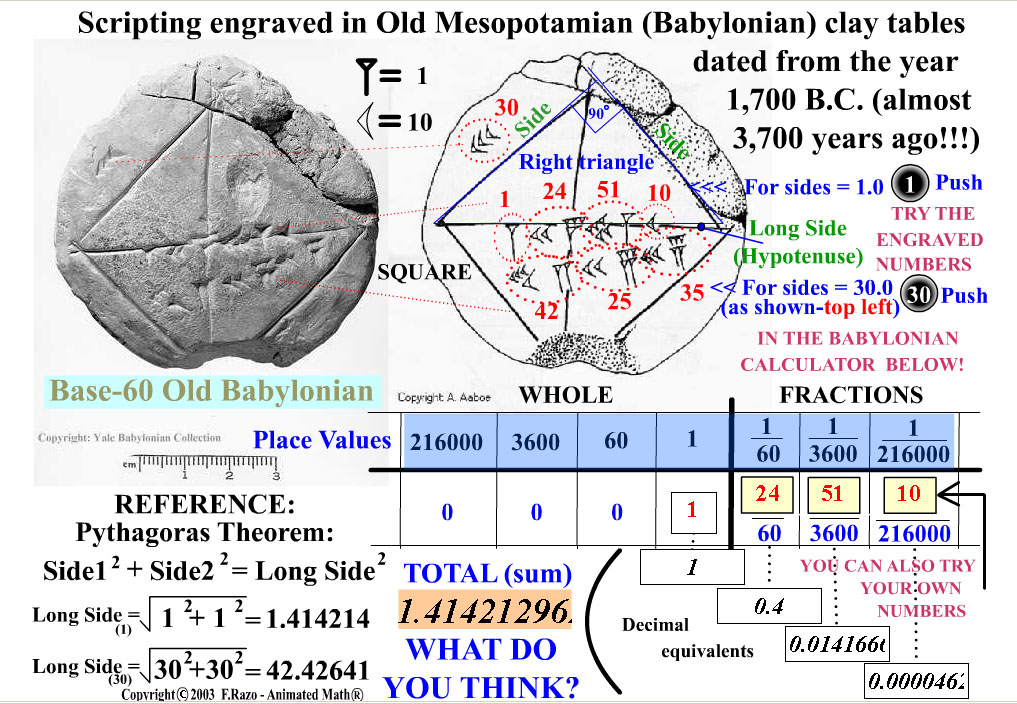 This
display features an ancient Babylonian clay tablet presenting the
relative size of the sides and diagonal of (2) right triangles. using
the
Base-60 number system prevalent at that time and place in history.
One group of numbers (upper) is for triangles is of size 1 and the
other (lower)is 30 units. Small, enclosed and sealed clay tablets
were used in ancient times to cast formal deeds among people. The
display therefore illustrates how base-number uniform fractioning
with increasingly smaller uniform breakdown pieces was already in use
since the beginning of our civilizations.
This
display features an ancient Babylonian clay tablet presenting the
relative size of the sides and diagonal of (2) right triangles. using
the
Base-60 number system prevalent at that time and place in history.
One group of numbers (upper) is for triangles is of size 1 and the
other (lower)is 30 units. Small, enclosed and sealed clay tablets
were used in ancient times to cast formal deeds among people. The
display therefore illustrates how base-number uniform fractioning
with increasingly smaller uniform breakdown pieces was already in use
since the beginning of our civilizations.
HANDS ON:
Wide-screen/Wireless-mouse or Touch-Screen
1.- Observe the
square shape engraved in the inch-wide clay tablet and the sequence
of multiples-of-60 place-value positions both for integers and
fractions, below it. Observe now the small clusters of symbols around
the diagonal in the middle of the square, representing the number of
integer and fraction pieces (1/60, 1/3600, ... ) for each of the two
corresponding diagonal sizes (use
the button for each given size).
Question: How many 3600'ths are
needed to represent the size of the diagonal of a square of unit
(side) 30 units?
a)
1
b) 25
b) 35 c)
60
2.- Looking at the
"REFERENCE" section on the bottom-left section of the
display, we can see the decimal calculation of the diagonals
(hypothenuse) using the Pythagorean Theorem (stated some 2000 years
later). Compare the value obtained in this section with the one
obtained from using the fraction numbers engraved on the tablet
(right section): How
different are they?
3.- For the sides of 30
units, notice that there is no number of 1/216000 fractions requested
for the diagonal, which appears to be the cause of a greater
difference between the two calculation forms.
Using the up/down
fraction number controls (red arrow-tips) for the 1/216000'ths
fractions determine the possible additional number in the sequence
that could have been engraved on the tablet to show the greatest
accuracy yet, using 1/216000 slices. (4)
Call the ANALOG
to DIGITAL (binary) electrical meter conversion display.
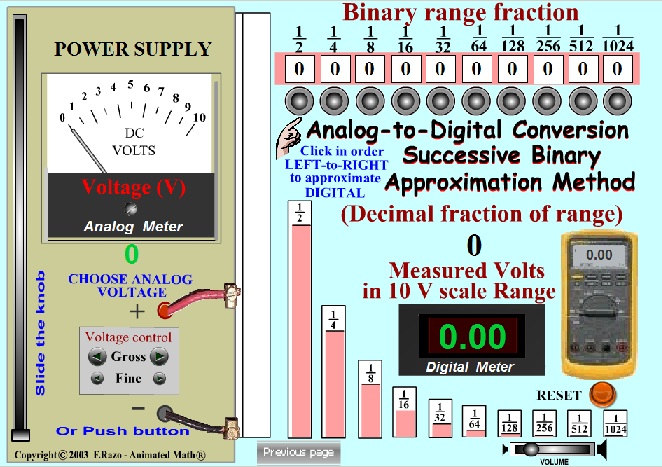 This
display illustrates the process of converting an analog voltage
measurement value, to a digitally encoded one, using the "successive
approximation" method involving binary fraction parts.
This
display illustrates the process of converting an analog voltage
measurement value, to a digitally encoded one, using the "successive
approximation" method involving binary fraction parts.
The analog value is shown on
the left, within a 10 Volt range controlled by a knob-slider and
displayed in a swinging-needle scale. The digital binary value is
constructed by successively adding and comparing reference half-range
fractions (from left to right) to differences, keeping each fraction
part if not reaching, or skipping it if they overflow as they
approach the target value.
HANDS ON:
Wide-screen/Wireless-mouse or Touch-Screen
1.- Set (slider) the
analog voltage on the left exactly to 5 volts (half range). What
would be the digital value needed to match the 5 volts?
|
a) 0000100000
|
b) 1000000000
|
c) 1010101010
|
d) 0000011111
|
2.- Set (slider) the
analog voltage on the left exactly to 9.5 volts. What would be the
digital value needed to match the 9.5 volts?
|
a) 1111001101
|
b) 1010101010
|
c) 1010001110
|
d) 1111011111
|
3.- Set (slider) the
analog voltage on the left exactly to 6.24 volts. What would be the
digital value needed to match the 6.24 volts?
|
a) 0000100000
|
b) 1000000000
|
c) 1010101010
|
d) 1001111111
|
3.- Set (slider) the
analog voltage on the left exactly to 1.5 volts. What would be the
digital value needed to match the 1.5 volts?
|
a) 0000100000
|
b) 0010011010
|
c) 1010101010
|
d) 1001111111
|
Call the
INTRABASES
CONVERTER display.
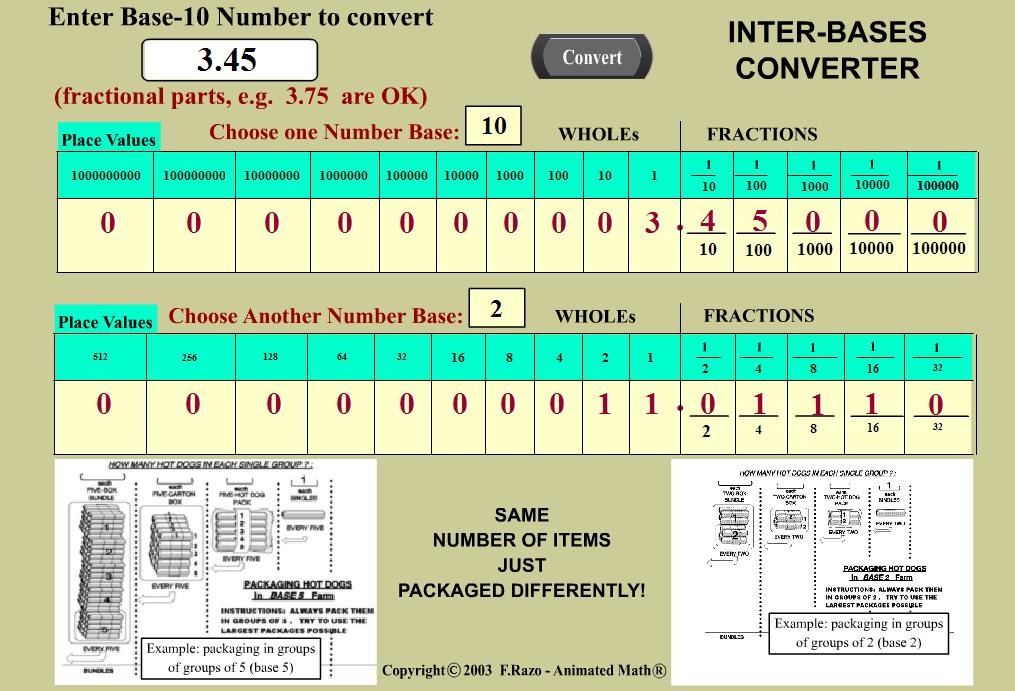 This
display allows comparisons of representation of numbers and fractions
involving various different base systems. A decimal target number at
the top and two optional number base representations are entered by
click-selecting a number entry window and keypadding it
correspondingly.
This
display allows comparisons of representation of numbers and fractions
involving various different base systems. A decimal target number at
the top and two optional number base representations are entered by
click-selecting a number entry window and keypadding it
correspondingly.
The analog value is shown on
the left, within a 10 Volt range value controlled by a knob-slider
and displayed in a swinging-needle scale. The digital binary value is
constructed by successively adding and comparing reference half-range
fractions (from left to right) to differences, keeping each fraction
part if not reaching, or skipping it if they overflow as they
approach the target value.
HANDS ON:
Wide-screen/Wireless-mouse or Touch-Screen
1.- Enter the number
20.5 base-10 and the bases 2 and 16 to observe (CONVERT button) the
binary (base 2) and hexadecimal (base 16) equivalents.
2.- Enter the number
100.75 base-10 and keep the bases 2 and 16 to observe the binary (2)
and hexadecimal (16) equivalents.
3.- Enter the number
42.426407 base-10 and bases 2 and 60 to observe the binary (2) and
Old-Babylonian (16) equivalents.
Can you recall the place
value numbers scribbled (for side 30) on the 4,000 year old
Babylonian clay tablet ( FRACTIONS
4,000 years ago ) for the diagonal of squares? (42, 25, 35,
+approx 4) - Comment: Isn't that ancient clay tablet an amazing
sample of the great mathematical abilities of our "primitive"
ancestors, 4,000 years ago!!?
Question: What
kinds of nice things we do today (e.g. regarding accuracy and
precision that help us design and produce the nice things we have now
such as microcircuits, skyscrappers, medical diagnosis and treatment,
megacities and supercomputers, conduct atomic and space exploration,
etc.) that allow us to advance our science, industry commerce and
research using what we learn here in our mathematics classes?
 This
display features the visual representation of fractions, as a
collection of a number of equal parts of a whole unit (“EVEN
BREAKUPS”). Both the total number of equal parts of the whole,
as well as the selected partial number of them, are set by using
corresponding slider bars (left and top). The fractions are shown in
both circle and rectangle forms, offering visual displays of how
portions of "a whole thing" can be represented using even,
manageable breakups of a “unit”, as convenient for
practical uses.
This
display features the visual representation of fractions, as a
collection of a number of equal parts of a whole unit (“EVEN
BREAKUPS”). Both the total number of equal parts of the whole,
as well as the selected partial number of them, are set by using
corresponding slider bars (left and top). The fractions are shown in
both circle and rectangle forms, offering visual displays of how
portions of "a whole thing" can be represented using even,
manageable breakups of a “unit”, as convenient for
practical uses.









